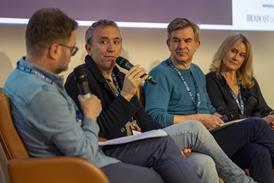Tape may be around for a while longer but production workflows are becoming increasingly file-based. Ann-Marie Corvin examines three stages of the production process which are using the latest in tapeless technology.
Acquisition
Two key formats are emerging as tapeless workhorses on TV productions - Sony’s XDCAM, which records onto DVD-like optical disks, and Panasonic’s P2, which records onto solid-state memory cards.
Each format has its followers - in April Sky announced that it plans to use Panasonic’s P2 on its news operations. The BBC also made Panasonic a preferred supplier following the broadcaster’s Starwinder project, which examined the performance of tapeless acquisition formats for capturing events such as the Torino 2006 Winter Olympics.
Meanwhile, XDCAM is emerging as a hit among production companies with high-volume, long-form commissions. RDF is using the cameras on Scrapheap Challenge while Lime Pictures is using XDCAM to record Hollyoaks and Grange Hill.
Because of its robustness XDCAM has also become an indispensable tool for users such as Alister Chapman, who spends a large amount of time storm-chasing for his archive business Ingenious TV, which specialises in supplying extreme weather footage.
He says: “With the old Digi Beta cameras I had to clean the camera heads quite often - I’ve not had to touch XDCAM in the 18 months I’ve been using it. I even put one of the optical disks through the dishwasher to test their durability - it came out fine.”
Another popular feature of XDCAM is its ability to view and edit proxy files (very small highly compressed versions of all the shots recorded during a shoot). “Proxy files are useful for the director or producer. You can run them on a cheap laptop and they don’t take long to load up [60 minutes of footage takes around five minutes to ingest]. Producers can then view the rushes as proxy files at their leisure,” says Chapman.
An edit carried out this way can also be saved back to XDCAM disk and used selectively to import the high resolution clips into the non-linear editing system, allowing an entire show to be cut using nothing more than proxies.
Perhaps because the genre employs similar workflows to live events or OBs, tapeless cameras are used on fast-turnaround dramas shot in a self-contained environment.
Lime Pictures makes around 260 episodes of Hollyoaks each year from the soap’s production village. The company’s Quantel-based post-production system is tapeless and, for the on-set scenes in Hollyoaks, the crew records from studio cameras straight into a server.
According to group head of production Jamie Hall, XDCAM is used on all the location scenes where the crew can’t get the cabling. Hall points out that it’s much easier to transfer files from the camera’s disk into the post-production system than it is to wait for tapes to ingest. “When you have a beast as big as ours, XDCAM saves a lot of time. The most obvious area is at the ingest point - it takes much less time to ingest material,” he says.
One advantage of solid-state recording systems such as Panasonic’s P2, or Sony’s latest XDCAM EX model, is that the ingest stage is faster still, making it a great application for news operations. Sky News is currently in the process of moving to Apple’s Final Cut Pro HD in the field to directly edit footage recorded on the P2 system.
Sky News head of cameras George Davies believes that solid state is best for news. “Disk-based cameras still require the equivalent of a VT machine to play the disk so essentially you still need a specialist recorder to ingest it into the computer.” He adds: “Because the P2 records data, you can just shoot, ingest and edit. It has got a huge range of connectivity in and out of the camera - you can send stuff anywhere in world with just a camera and a laptop.”
There are also time and cost-saving advantages in breaking news if you are able to feed information straight from a camera into a laptop or common or garden PC, as Davies points out: “An hour’s connectivity in Starbucks is much cheaper than hiring a satellite truck with an uplink.”
Post-production
Because the majority of productions use tape at the beginning and end of the process, there are few external post houses that can claim to be part of an end-to-end tapeless workflow.
Last year the BBC’s Production Gateway project selected a handful of Soho facilities to experiment with tapeless workflow and delivery as part of the broadcaster’s goal to become a fully tapeless organisation by 2010.
The next stage, Gateway 2, involves three key moves - appointing a third party network supplier to manage the operation; opening up the project to other broadcasters and facilities; and examining business models (chiefly, how should the costs of storage, delivery and management be borne between production companies, facilities and broadcasters).
Currently, most examples of tapeless post involve the editing of live and near live events packages at music festivals and sport fixtures. In July the BBC’s coverage of the Live Earth concert became one of the most wide-scale examples of this model.
BBC Resources supported 22 hours of live high-definition coverage that went out to more than 135 countries. Resources’ new HD studio, Studio 8 at Television Centre in London, became the hub for the operation, where content arrived and was packaged up by BBC Resources for different international broadcasters.
The programme was made in a tapeless HD environment using 8TB of EVS server storage to record the concerts and provide live server-based editing of all the footage.
“The main issues were getting the signals in and out at the right time and getting the right standards conversions,” recalls BBC Resources head of technology Andy King. To make this possible, BBC Post Production used a Snell and Wilcox Alchemist Ph.C-HD frame rate standards converter. According to King, the tapeless workflow is a time saver. “It allows the craft editor to find the material more easily. Also, because you are getting stuff on screen faster, you are also benefiting the audience because it allows you to put more content on screen.”
King argues that there is a big difference between the EVS/Avid model of event production used on Live Earth and the workflow sometimes referred to as “tapeless” which was applied on BBC natural history series Planet Earth.
Planet Earth was finished using a workflow that encompassed Smoke, Lustre and Sledgehammer, while ingesting the film from HD Shadow telecine at 4:4:4 directly to the Smoke. While no tape was used in this stage of the production process, according to King, the correct term for this post-production workflow is “file-based”.
“Editing a programme going through the EVS/Avid workflow is a truly tapeless environment because it behaves like a video machine. It’s not tape, but you can move content around in real time - like video. In the data-based world of Planet Earth, however, you are not moving content around in real time because the files are too large. You couldn’t shoot live sport in uncompressed HD - the quality would be better but it would take five times as long to see the action.”
To this end, most post facilities working on long-form documentaries and drama are moving towards a file-based workflow, which simply involves using less tape. “I prefer to think in terms of data,” says Shane Warden, joint managing director of Pepper Post Production. “The fact is that tape will still play a part in what we do over the next five or 10 years - if for nothing else but archive and back-up purposes.”
The model Pepper works on is that clients bring in film or tape (or any other format) and the facility puts it on its Storage Area Network (SAN) and converts these pictures into data until they are ready to be reconverted into the format the client chooses.
Playout
To increase access to archived material and to be able to offer new media services, several broadcasters, including Discovery and Virgin Media, have made the move from a tape-based to a file-based archive and playout operation. Again, the term “tapeless” isn’t strictly correct when referring to this new way of working, but the transition towards a more file-based workflow is becoming common practice.
Channel 4 recently completed the first stage of its file-based transition - dubbed the Media Access Project (MAP). The project, designed in partnership with the broadcaster’s technology partner and systems integrator, Pharos Mediator Enterprise, involved migrating C4’s current tape-based operation to a file-based acquisition, archive and media access system.
The system revolves around a Pharos Mediator media management system and three Omneon servers. The MAP ingests C4 shows at both browse level and at full 50Mbit/s I-frame-only MPEG-2 transmission resolution to a 36TB Isilon server. Content is then transferred to Pinnacle servers for file-based playout. This set-up means that C4 and its digital channels are able to perform their entire broadcast operation from Channel’s online digital library store.
In terms of its archive solution, it’s still too costly for a broadcaster with a vast back catalogue to store all its material on hard disk, and digital tape is the only cost-effective option, according to C4 chief technology officer Kevin Burrows.
Consequently, all C4’s digitised material is stored at a Sony petasite - a warehoused library which stores digital tape that can be automatically retrieved.
“We have a large disk storage for general transfer and encoding but it’s not big enough to store 25 years of archived programming,” says Burrows.
According to Burrows, the main reason for C4 switching from a tape-based to a file-based system is to service external clients by making the content easily available on any platform. “When we launched 4oD a year ago it changed the priority of the project - we needed to service clients such as Virgin Media and Tiscali. The MAP is designed for scalability, and the next stage will be to integrate the operation with our post-production and graphics side,” he says.
For smaller companies that don’t have a big archive operation, investing in hard disks rather than ploughing money into automation and a petasite should be a consideration, according to Portland TV technical director Jon Anthony.
Portland, the broadcasting arm of Northern and Shell (which transmits adult channels Television X and Red Hot, as well as third party gaming channels), decided to bring its playout in-house in March 2005. Six months and£1m later, the in-house operation was up and running with 32 channels of playout. Key suppliers included Dell EMC iSCSI for storage, Leitch (now Harris) Nexio servers for playout and Rhozet carbon coding engines for transcoding.
By ignoring the traditional wisdom of investing in a complicated automation system and opting to play content solely off the server, Anthony claims Portland made a huge cost saving. “We had to write a playlist program but this was fairly simple and based on XML databases. He adds: “Traditionally you are meant to have two main routers. Being tapeless simplified our output chain to the point that we did not need any routers.
“We were advised that we would not find a company that would work with Leitch’s proprietary file format, but we sent a sample Leitch file to Rhozet and it added it to its list of supported formats within a fortnight,” he says.
For this type of operation, however, insisting that your suppliers provide security measures and back-up is crucial, as Anthony recalls: “We specifically insisted that the playout head manufacturer [Leitch] could give us a four-hour on-site response 24/7.”
Anthony maintains that the role of the scheduler is much easier now that the material is digital. “The entire library can be viewed with remote desktop players. This allows schedulers to actually check what they are scheduling.”
He adds that this kind of tapeless workflow can also be a blessing when it comes to making adjustments to adverts and promos - content which is frequently subject to last-minute changes. “Having the edit suites directly connected to the transmission centre changes what was once a nightmare into standard practice and eliminates a large part of the stress associated with last minute demands,” he says.





























No comments yet